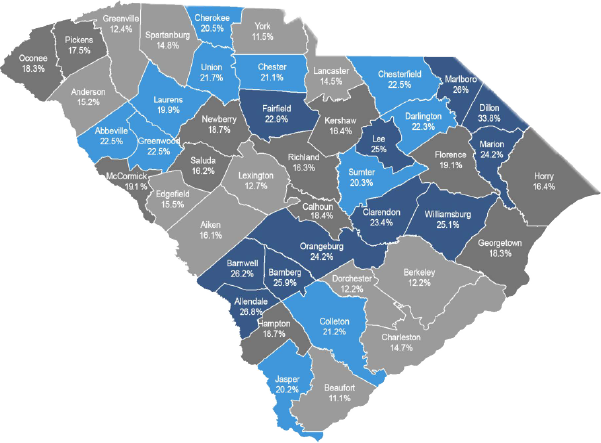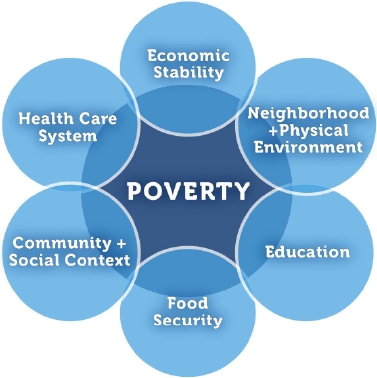Poverty in South Carolina
Poverty in South Carolina is a complex, multifactorial phenomenon that needs to be examined as such. In 2020, we partnered with the Rural & Minority Health Research Center at the University of South Carolina to produce the “Structural Factors Associated with Poverty” research study, which quantitatively assessed the factors that contribute to poverty in South Carolina.
The goal of this research was “to identify, acknowledge, and examine the systemic and policy factors that lead to, reinforce, and exacerbate poverty specifically for residents of South Carolina.”

Percent of Poverty in South Carolina
In the United States, poverty estimates are calculated as the share of the population that falls below a certain income based on family size. According to the U.S. Census Bureau, in 2018, an estimated 16% of South Carolina’s population experienced poverty, compared to the national average of 14.1%. Importantly, this number only reflects a count of the population experiencing poverty without capturing the depth or severity of need.
Conceptual Model
In order to effectively address poverty, it is necessary to understand and use an underlying theory of its causes. Our research utilized a structuralist approach, focusing on factors that are outside individual control or are at an institutional, community or public policy level. Investigating these factors with a specific lens towards their contributions to poverty may broaden and deepen the understanding of the needs of people in society.

Structural Factors
Six structural factors — economic stability, neighborhood and physical environment, education, food security, community and social context, and health care — were evaluated to identify the systemic and policy issues related to each that lead to, reinforce, and exacerbate poverty in the state. Most of the issues examined showed that the outcomes associated with each factor are poor in South Carolina, especially when compared to the U.S. as a whole.
1
ECONOMIC STABILITY
As of 2018
27%
of South Carolinians have medical debt in collections which ranks
second in the nation
compared to 16% nationally.
2
NEIGHBORHOOD AND PHYSICAL ENVIRONMENT
80%
of South Carolina’s Counties are at or above the national average for evictions.
3
EDUCATION
53%
of South Carolina children ages 3-4 between 2016-2018 were not enrolled in any type of school.
4
FOOD SECURITY
In 2015, approximately
2.3M
of South Carolina’s residents lived in areas of low food access.
5
COMMUNITY AND SOCIAL CONTEXT
52%
of the state’s 46 counties are identified to have persistent child poverty.
6
HEALTHCARE SYSTEM
In 2018
500,000+
people in South Carolina did not have health insurance at all due to high cost or lack of access through an employer.
Racial Disparities Across the Continuum
In 2018, African American residents in South Carolina represented 43% of the population in poverty — yet only 27% of the state’s population.
Lower overall investments in public education were found in counties with higher proportions of African American residents.
30.2% of the Hispanic population in South Carolina were uninsured compared to 19.2% nationally.
Women in South Carolina earned 72.2% of their male counterparts' salary in 2018. This gap was even larger for Black, Hispanic and Asian American women in the state.
52.9 % of African American residents received SNAP in South Carolina, while the national average is 26.2%.
WANT TO GET INVOLVED?
Contact us.
Email us for more information about our advocacy and research initiatives.


